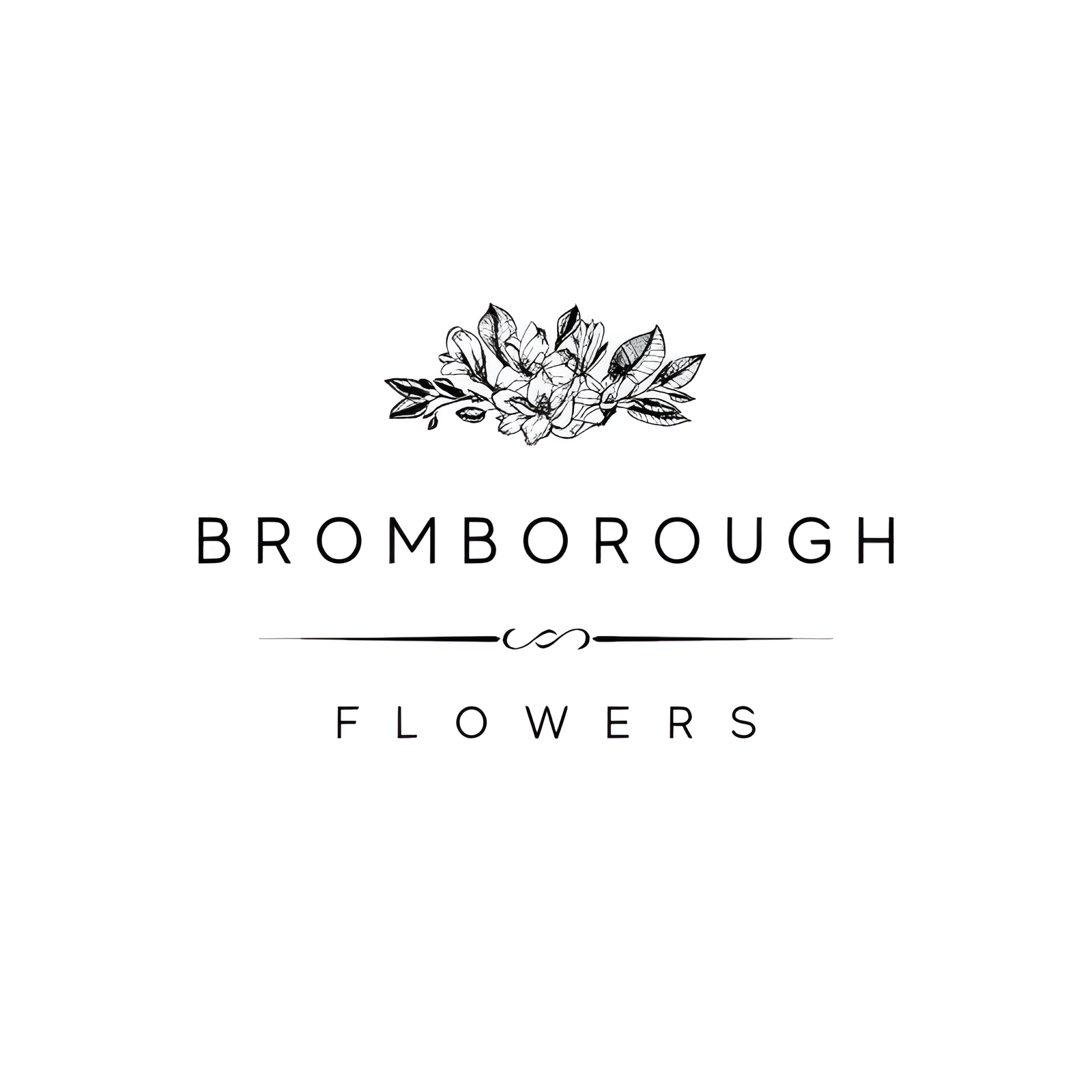In the world of wedding florals, magnolias stand out for their grandeur and symbolic richness. Their sizable, aromatic blossoms in hues of white, pink, purple, and yellow not only enhance the visual appeal but also carry deep meanings of strength, resilience, and purity. As couples seek to infuse their ceremony with elegance and significance, the choice of magnolias offers an unparalleled blend of beauty and sentiment. Imagine these exquisite flowers adorning your special day, embodying new beginnings and lasting love. But what makes magnolias uniquely suited for weddings, and how can they best be utilized to create memorable floral arrangements?
Flower Overview
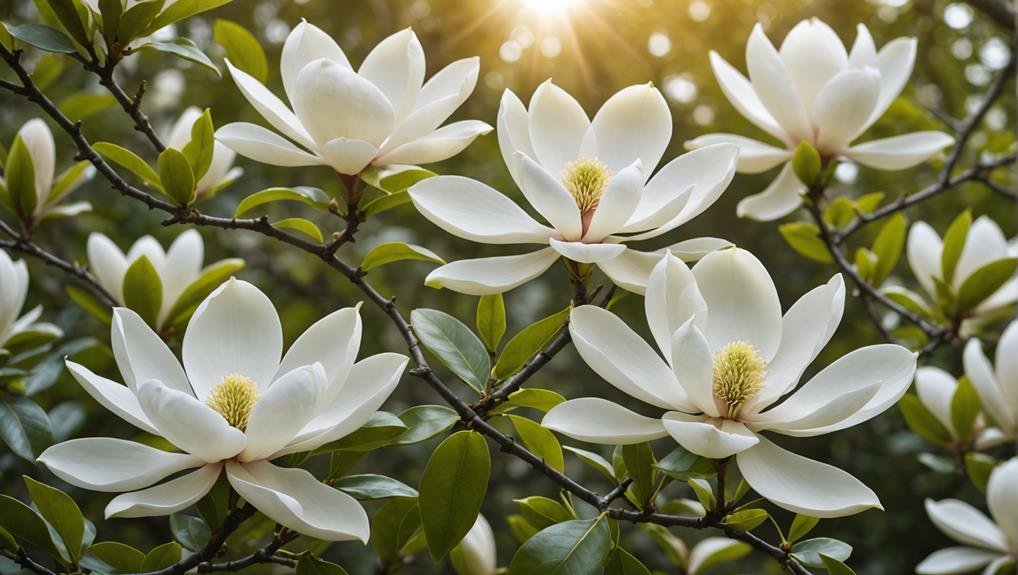
Magnolias, with their iconic star-like leaves and enchanting blossoms, are celebrated for their versatility and aesthetic appeal in various environments. Magnolia flowers are particularly renowned for their striking beauty and aromatic presence, making them a favored choice for both outdoor gardens and indoor settings. These flowers come in a range of colors, including white, pink, purple, and yellow, each carrying its own symbolic meaning—white for purity, pink for joy, purple for dignity, and yellow for prosperity.
Magnolia flowers are not just visually appealing but also evoke a sense of elegance and timelessness. Their large, waxy petals and unique, cup-shaped blooms make them a standout feature in any floral arrangement. This versatility extends to their adaptability in various climates, allowing them to thrive in different parts of the United States, with a strong association with the southern states.
Additionally, magnolia flowers are known for their enduring strength and resilience, symbolizing nobility and perseverance. This combination of aesthetic beauty and symbolic richness makes magnolias an excellent choice for weddings and other significant events, where their presence can add a touch of natural splendor and meaningful elegance.
Physical Description
Characterized by their large, fragrant blooms and thick, waxy petals, magnolia flowers present a striking and durable beauty in various shades of white, pink, and purple. These flowers, often considered the epitome of elegance, are a prominent feature of the magnolia tree. Their substantial size and unique structure, with a central cone surrounded by multiple layers of petals, make them a distinctive choice for wedding decorations and bouquets.
The magnolia tree itself provides an exquisite backdrop for these blooms. Its leaves are glossy, dark green, and leathery, creating a lush contrast that enhances the flower’s visual appeal. The thickness of the petals not only contributes to their long-lasting nature but also adds a tactile element to their charm. This durability is particularly advantageous for weddings, where the flowers must maintain their freshness and beauty throughout the event.
Adding to their allure, some magnolia varieties emit a citrusy or fruity fragrance, which can subtly infuse the wedding atmosphere with a pleasant scent. The combination of their visual and olfactory appeal makes magnolia flowers a favored choice for couples seeking both beauty and resilience in their floral arrangements.
Available Colour Varieties
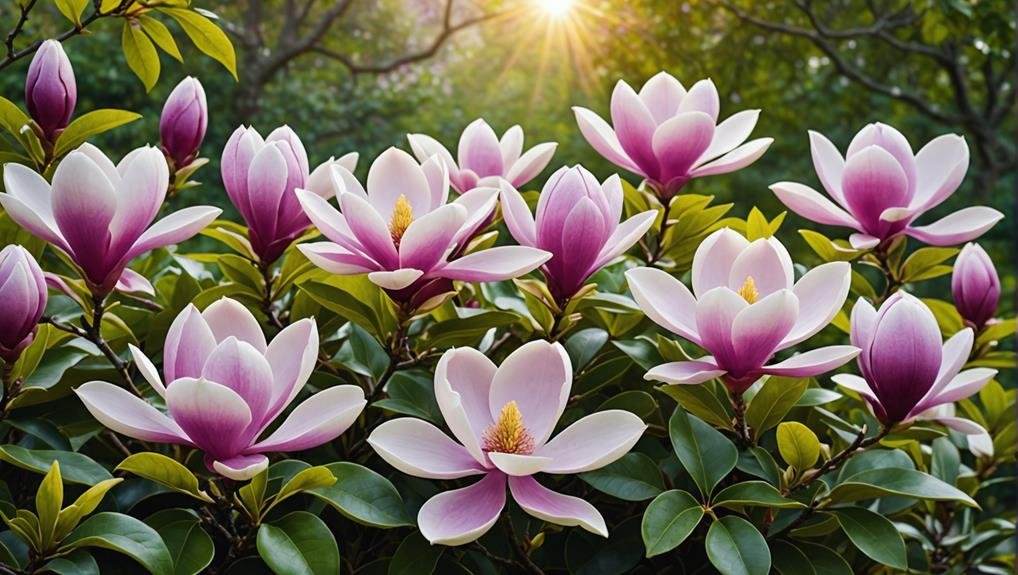
In the world of wedding florals, the magnolia’s diverse color palette offers an array of hues, from pristine white to vibrant pink and even soft purple, catering to a multitude of aesthetic preferences. The color varieties of magnolia flowers can greatly enhance wedding decor, offering both versatility and stunning visual appeal. For instance, the Southern magnolia is renowned for its large, white blooms that exude elegance and simplicity. Meanwhile, the Saucer magnolia showcases a charming mix of pink and purple hues, adding a touch of romance and sophistication to any arrangement.
Magnolia stellata, with its white star-shaped flowers, brings a delicate and ethereal quality to wedding designs. Additionally, certain magnolia species also present yellow blooms, providing a unique and cheerful option for those seeking a less conventional but equally beautiful floral choice.
| Magnolia Species | Primary Color(s) | Notable Features |
|---|---|---|
| Southern Magnolia | White | Large, elegant blooms |
| Saucer Magnolia | Pink, Purple | Alluring mix, romantic and sophisticated |
| Magnolia Stellata | White | Delicate, star-shaped flowers |
| Varied Magnolia Species | Yellow | Unique, cheerful blooms |
The wide range of color varieties available ensures that magnolias can complement any wedding theme, from classic to contemporary.
Latin Name and Taxonomy
The Latin name for the magnolia, Magnolia grandiflora, situates it within the Magnoliaceae family, reflecting its ancient and storied botanical lineage. This genus comprises approximately 210 flowering plant species renowned for their large, fragrant blooms. Magnolia grandiflora, in particular, is celebrated for its majestic presence and is a popular choice for wedding arrangements.
Taxonomically, magnolias fall under the order Magnoliales, highlighting their classification among some of the most primitive flowering plants. This places them in a unique position within the plant kingdom, as they have a long evolutionary history that dates back millions of years. Fossil records have provided evidence of their ancient lineage, underscoring their resilience and longevity through various geological epochs.
Within the genus, there are several notable species, including Magnolia virginiana, Magnolia stellata, and Magnolia acuminata, each contributing to the diverse array of forms and characteristics found among magnolias. The taxonomy of magnolias is meticulously structured, reflecting their evolutionary development and the distinct features that set them apart from other flowering plants.
Understanding the taxonomic classification of Magnolia grandiflora provides valuable insights into its historical significance and enduring appeal, particularly in the context of its use in wedding decor.
Geographical Origins
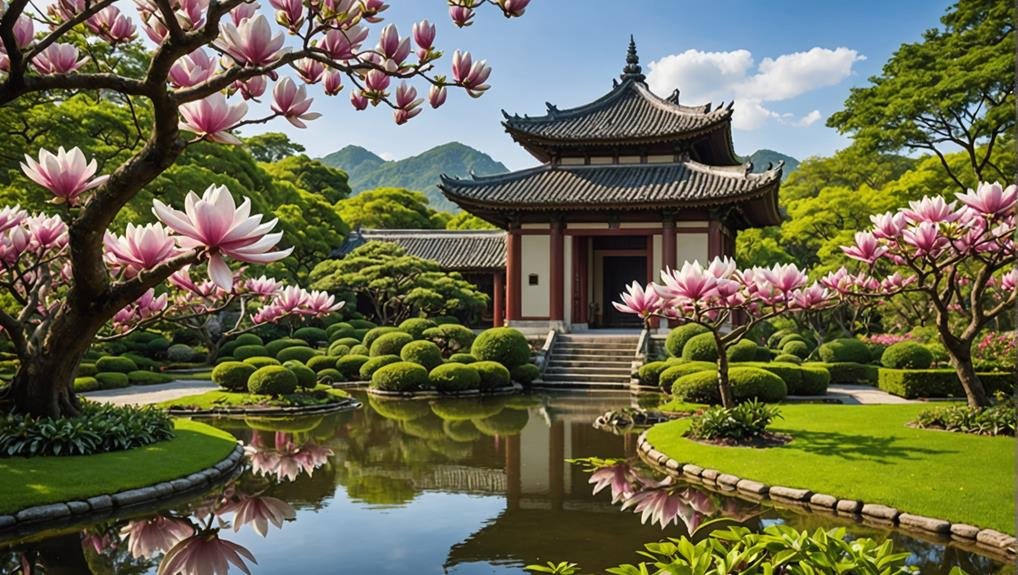
Magnolias, with their ancient lineage and diverse species, originate from a wide range of geographical regions including East and Southeast Asia, North America, Central America, and the West Indies. This extensive geographical distribution has contributed to the vast diversity within the Magnolia genus, which includes over 200 species.
East and Southeast Asia boast a significant number of magnolia species, many of which have been cultivated for centuries due to their striking beauty and cultural significance.
In North America, the iconic Magnolia grandiflora, commonly known as the Southern magnolia, is a notable species native to the southeastern United States. This particular species is renowned for its large, fragrant white flowers and glossy evergreen leaves, making it a popular choice for wedding arrangements.
Central America and the West Indies also host a variety of magnolia species, each adapted to their unique climatic conditions. The geographical origins of magnolias span from tropical regions, where certain species thrive in warm, humid environments, to temperate zones, where others are well-suited to cooler climates.
This adaptability has facilitated the cultivation and hybridization of magnolias worldwide, resulting in a wide range of varieties available for various uses, including wedding decorations.
Season Availability
Seasonal availability of magnolia flowers is primarily from late winter to early summer, aligning perfectly with spring and early summer weddings. The enchanting magnolia blooms, renowned for their elegance and fragrance, are most abundant during late spring. This period offers a diverse selection of magnolia varieties, each presenting a unique palette of colors and sizes, ideal for creating stunning wedding arrangements.
While magnolias are generally available during this broad timeframe, specific varieties may have slightly different blooming periods. Some types of magnolia might blossom earlier in late winter, while others peak closer to early summer. Thus, understanding the precise seasonal availability of the particular magnolia variety you desire is important when planning your wedding date. This ensures you receive the freshest and most vibrant blooms for your special day.
For those planning weddings in late winter or early spring, magnolia flowers provide an excellent choice, delivering both visual appeal and a delightful fragrance.
Growing Conditions
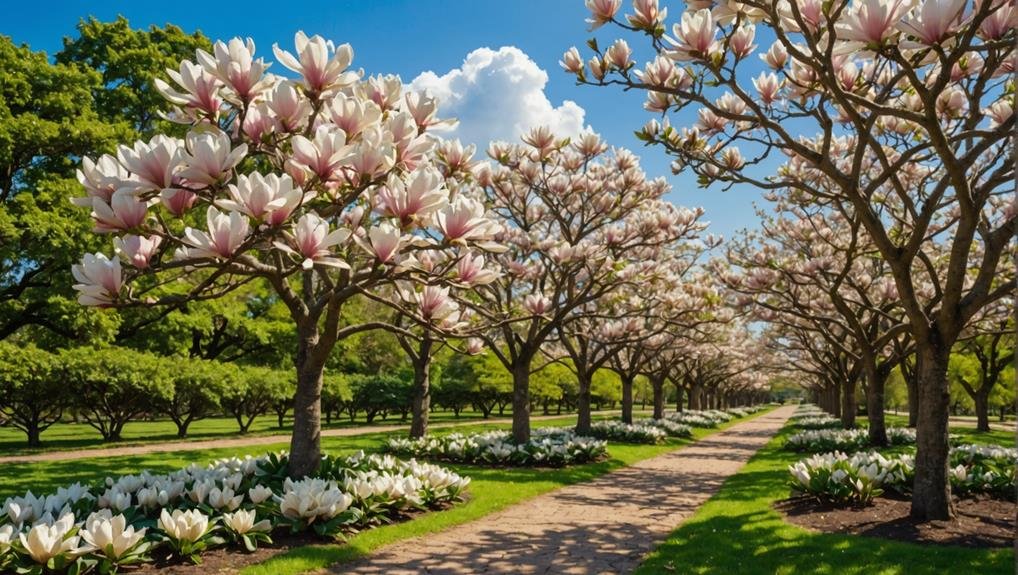
Best development of magnolias necessitates well-drained, acidic soil paired with full sun to partial shade exposure. These conditions are crucial for maximizing magnolias not only thrive but also yield their characteristic large, fragrant blooms.
Additionally, magnolias typically prefer moist soil during their growing season, making regular watering crucial, especially in dry periods. Mulching around the base of the plants can help retain soil moisture and regulate temperature.
Magnolias are generally low-maintenance once established; however, protection from strong winds is advisable to prevent damage to their delicate branches and blooms. Different magnolia varieties may have specific temperature and climate preferences, so it is vital to select a variety suited to your local environment.
For example, some magnolias are more tolerant of colder climates, while others flourish in warmer regions. Regular pruning can help shape magnolia trees and promote healthy growth. It is optimal to prune after the flowering season to avoid cutting off next year’s buds.
Cultural Significance
In various cultures, the magnolia flower is revered as a symbol of natural beauty, purity, and enduring strength. This elegant bloom carries a rich history and deep cultural significance, making it a popular choice for wedding flowers. The magnolia’s association with nobility and resilience is evident across different societies, where the flower is often seen as a representation of long-lasting love and endurance.
The cultural importance of magnolias can be highlighted through their distinct attributes:
- Symbolism: Magnolias symbolize purity and perfection, especially in their white form, which is often chosen to convey innocence and a fresh start in life.
- Tradition: In many cultures, magnolias are incorporated into wedding ceremonies to symbolize the purity and strength of the couple’s union.
- Longevity: The magnolia tree itself is celebrated for its strength and longevity, qualities that resonate with the idea of eternal love and commitment.
The different colors of magnolias also play a role in their cultural significance, with each hue conveying specific meanings that add depth to their use in weddings. This rich symbolism and historical weight make magnolias a deeply meaningful choice for wedding flowers, embodying both beauty and profound cultural values.
Typical Use in Weddings
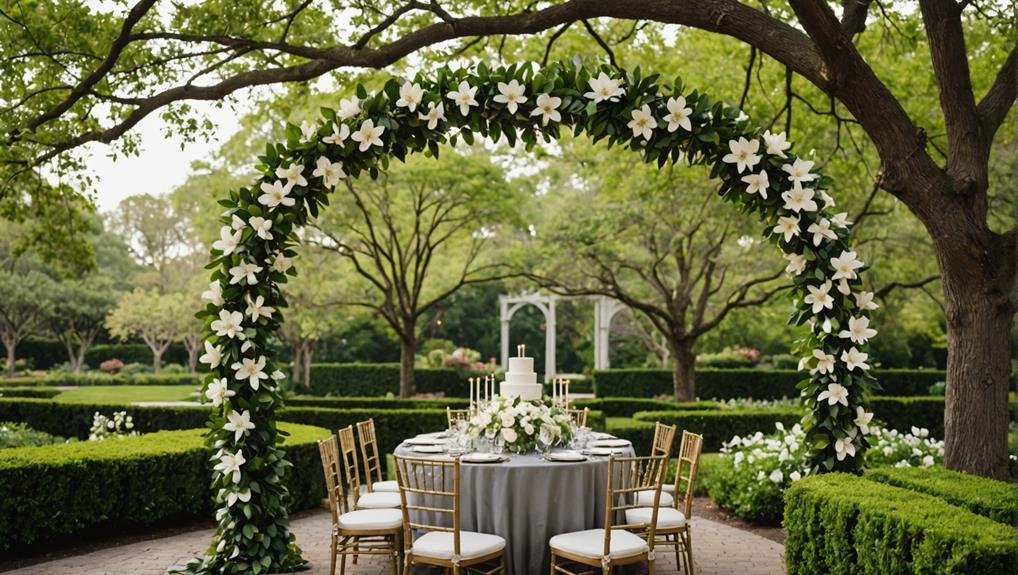
Incorporating magnolias into wedding decor is a timeless choice that enhances the elegance and sophistication of the event. These exquisite flowers are frequently used in wedding bouquets, centerpieces, and other floral arrangements. Their natural beauty and fragrant elegance make them a sought-after choice for brides looking to add a touch of sophistication to their special day.
Magnolia varieties such as Grandiflora, Virginiana, and Merrill are particularly favored for wedding bouquets. These varieties bring different textures and hues, allowing for versatility in floral design. Florists often secure magnolia blooms with stems intact using florist tape, guaranteeing they remain fresh and beautifully arranged throughout the ceremony and reception. Additionally, magnolia leaves are incorporated into bouquets to provide structural support and enhance the overall aesthetic appeal.
Here is a concise overview of popular magnolia varieties and their uses:
| Magnolia Variety | Typical Use in Weddings |
|---|---|
| Grandiflora | Wedding bouquets and centerpieces |
| Virginiana | Bridal bouquets and floral arches |
| Merrill | Boutonnieres and table arrangements |
With their timeless appeal and versatility, magnolias continue to be a favorite choice for wedding floral decor, seamlessly blending natural beauty with sophisticated elegance. Their incorporation in wedding bouquets and other arrangements guarantees a memorable and visually stunning celebration.
Alternative Flower Types
Exploring alternative flower types can offer diverse and equally stunning options for wedding decor when magnolias are unavailable. Whether due to seasonal limitations or personal preferences, several flowers can beautifully complement various wedding themes and styles. Consider the following alternatives, each bringing its own unique charm:
Peonies
Peonies are known for their romantic and lush appearance. They come in a variety of colors, from soft pastels to vibrant hues, making them versatile for different wedding palettes. Their full, rounded blooms add a touch of elegance and romance to any arrangement.
Garden Roses
Garden roses exude sophistication and timeless beauty. Unlike standard roses, garden roses have a more intricate petal structure and a delightful fragrance. They are perfect for creating elegant, classic wedding bouquets and centerpieces.
Hydrangeas
Hydrangeas are ideal for creating full and voluminous arrangements. Available in colors such as white, blue, pink, and purple, they can easily match or complement your wedding theme. Hydrangeas symbolize heartfelt emotions, making them a meaningful choice for wedding decor.
